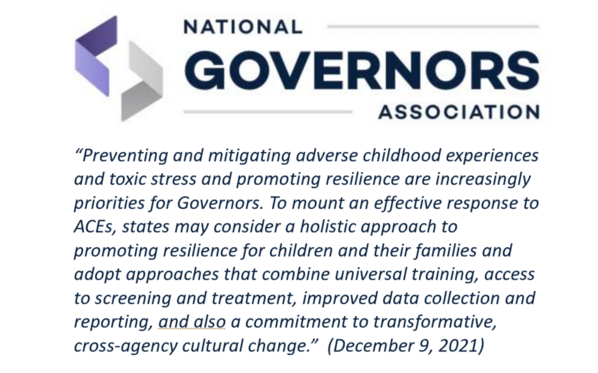“There is no way that Delaware would have built the connections and gained the understanding that we have without participating in the National Governors Association (NGA) Addressing ACEs Learning Collaborative,” says Alonna Berry.
Berry, Delaware’s statewide trauma-informed care coordinator, said that the impact (of the Collaborative) was “really immeasurable to the progress being made in Delaware.”
The 12-page NGA report, released December 9, captures the essence of a variety of statewide approaches to address ACEs across the lifespan, both from the states selected for the project (Delaware, Maryland, Pennsylvania, Virginia, and Wyoming) and the “models” that provided expertise about statewide approaches to address ACEs (Alaska, California, New Jersey, and Tennessee).
PACEs Connection, the MARC (Mobilizing Action for Resilient Communities) project, and others have documented the stories of many statewide networks, some of which are states involved in the NGA Collaborative but others, too, including early pioneering states such as Arizona, Iowa, Washington, and Wisconsin.
The Collaborative, launched in June 2020, is winding down now while the pandemic rages. The COVID pandemic required changes in the logistics of the NGA learning lab (e.g., in-person meetings were replaced with virtual ones) and brought urgency and relevancy to project, as the pandemic exacerbated the existing impact of ACEs on problems the states were already addressing.
In the time of COVID
Both Berry and Dan Jurman, executive director of the Office of Advocacy & Reform in Pennsylvania Governor Tom Wolf’s administration, commented in recent interviews about the impact of COVID on the project. Jurman said the Collaborative was both “a slice of normalcy in the pandemic” and made it more urgent and relevant as state government grappled with existing problems such as child abuse, domestic violence, food insecurity, and income inequality. Jurman makes the point that everyone is experiencing trauma either directly or indirectly from the pandemic and at the same time coping with societal upheaval reflected in the racial reckoning, increases in violence and extremism, and a polarizing political environment. He also sees the widespread and growing mistrust of government and civic institutions as another layer of trauma being experienced by many during the pandemic.
Berry makes similar points saying that because COVID is a dominant concern inside and outside government “it's nearly impossible not to draw the connections between the conversations we're having about becoming trauma informed and the kind of collective trauma that we're all living through.” Being able to convene virtually during the Collaborative meant that more state officials could participate and address how state government could support its own employees and frontline workers, according to Berry.
Jurman warns that “any state that ignores trauma and ACEs does so at their peril.” He points to the trauma experienced by every child living through the pandemic, the number of children orphaned, the impact of long COVID on the health and financial stability of parents and other caregivers, the increase in violence, extremism, and child abuse deaths.
Susan Burns with the Delaware Children’s Department who participated in the Collaborative points to the long-term impact of the pandemic on the state workforce and frontline workers. Strategies are being developed to address the stress of high caseloads of frontline workers and the stress of parenting and caregiving in the pandemic. Educating about trauma and ACEs is one part of the strategy. Burns says the resources available through the Harvard Center for the Developing Child are useful for state agency personnel while the resources from The Number Story are valuable for educating parents and other lay people.
The Report
The report summarized the four areas of focus that emerged from the participating states:
- Establishing trauma-informed states by creating a holistic, cross-agency vision for cultural change;
This section highlights Building Strong Brains Tennessee (BSBTN) calling it “a national model for statewide culture change, governance, and public-private partnerships.” It links to a separate NGA report A Case Study of Building Strong Brains Tennessee: An Initiative to Address Adverse Childhood Experiences and Become a Trauma-Informed State. It also provides brief summaries of the work in New Jersey, Delaware, Virginia, Pennsylvania, and Maryland. New Jersey established an Office of Resilience in June 2020, funded by philanthropic organizations and in partnership with the NJ Department of Children and Families—a structure that other states found to be a model. Governors in the other four states signed Executive Orders that provided guidance on how each state achieves being trauma-informed. The resource section includes links to all the statewide plans, executive orders, and internal planning and analysis documents.
- Developing a common, statewide language and lens around trauma and ACEs and implementing universal trauma awareness communications and/or training;
Descriptions are included in this section on how Tennessee, Delaware, Pennsylvania, and Virginia developed “statewide language and framework for discussing ACEs and their impact on later life outcomes.” After a common language was developed in Tennessee by working with the Frameworks Institute, the report says that to date, 80,000 people, including 7,000 educators and administrators, have been trained. Tennessee used materials developed with the Harvard Center for the Developing Child and others for its train-the-trainer effort. Other organizations such as ACE Interface have provided training in states including Virginia, Maryland, New Jersey and Wyoming.
- Improving the quality of ACEs surveillance data;
This section provides details on the Alaska Longitudinal Child Abuse and Neglect Linkage Project (ALCANLink), a strategy that links the Pregnancy Risk Assessment Monitoring System (PRAMS) data with administrative data sources to “identify families at high risk of child welfare involvement and elevated ACEs in early childhood.” Research and models using ALCANLink have found that “child maltreatment prevention efforts focused on minimizing household challenges should begin before birth, and resources and prevention programs should remain actively available to families throughout childhood.” Alaska used ALCANLink data in its application for a Centers for Medicare and Medicaid Services Section 1115 demonstration, making Alaska the first state with a demonstration through which individuals qualify for services based on having experienced ACEs.
The report references other important data initiatives such as the ACEs module in the Behavioral Risk Factor Surveillance (BRFSS) survey (now done in all 50 states and the District of Columbia), and the Youth Risk Behavioral Survey (YRBS)
- Increasing access to ACEs screening and developing a comprehensive, trauma-informed system of care.
This section highlights California’s ACEs Aware initiative (more details are available in the “Case Study of California’s ACEs Aware Initiative” developed for this Collaborative) and includes information on screening and developing a trauma-informed system of care. It also describes efforts in Wyoming to secure Medicaid reimbursement for screening and to connect individuals with services. It also provides information on Virginia’s Trauma Informed Model of Service Delivery that includes screening and referrals.
While neither the final report or the case study of California’s ACEs Aware Initiative cover the different viewpoints on screening for ACEs in healthcare and other settings, it is important to acknowledge the controversy. For example, the New Jersey ACEs Collaborative has a stated position that screening for “ACEs by care providers should be used as a means to provide assistance and referrals to children and families, not as a diagnostic or treatment tool.” Two articles (attached) in the American Journal of Preventive Medicine explore some of the issues around the use of screening in clinical or medical models.
Conclusion
The statewide approaches to prevent and mitigate ACEs and build resilience covered in this report and elsewhere demonstrate that there are many different pathways to reach common goals. The NGA report makes a significant contribution to our knowledge about different state initiatives but more work is needed and questions remain.
Should financial formulas for state and local spending target resources to communities with high ACE prevalence, as suggested by one activist? How do we track the progress being made and challenges being tackled in states where initiatives are underway?
Use the comment box below to let us know what ideas and thoughts you might have. Learn more about the NGA initiative by joining the CTIPP-CAN (Campaign for Trauma-Informed Policy and Practice—Community Advocacy Network) call on Wednesday, December 15 (2:00-3:30 PM ET) and hear from Chidi Jenkins, advisor on childhood trauma and resiliency in Virginia Governor Ralph Northam's Office and Dr. Shelby Hockenberry, program director of healthcare delivery at the National Governors Association. See the attached document for the link to join the call.





Comments (1)